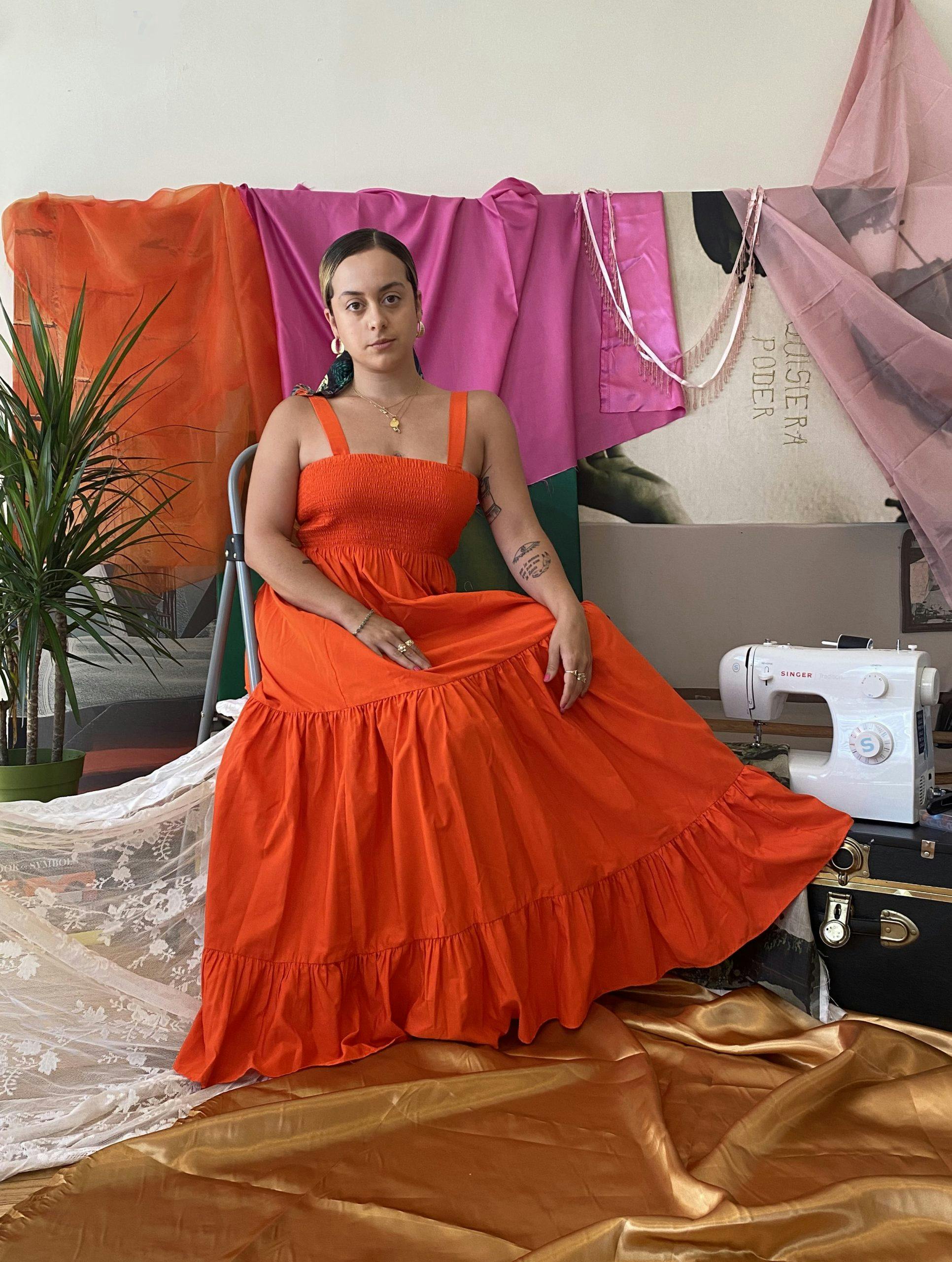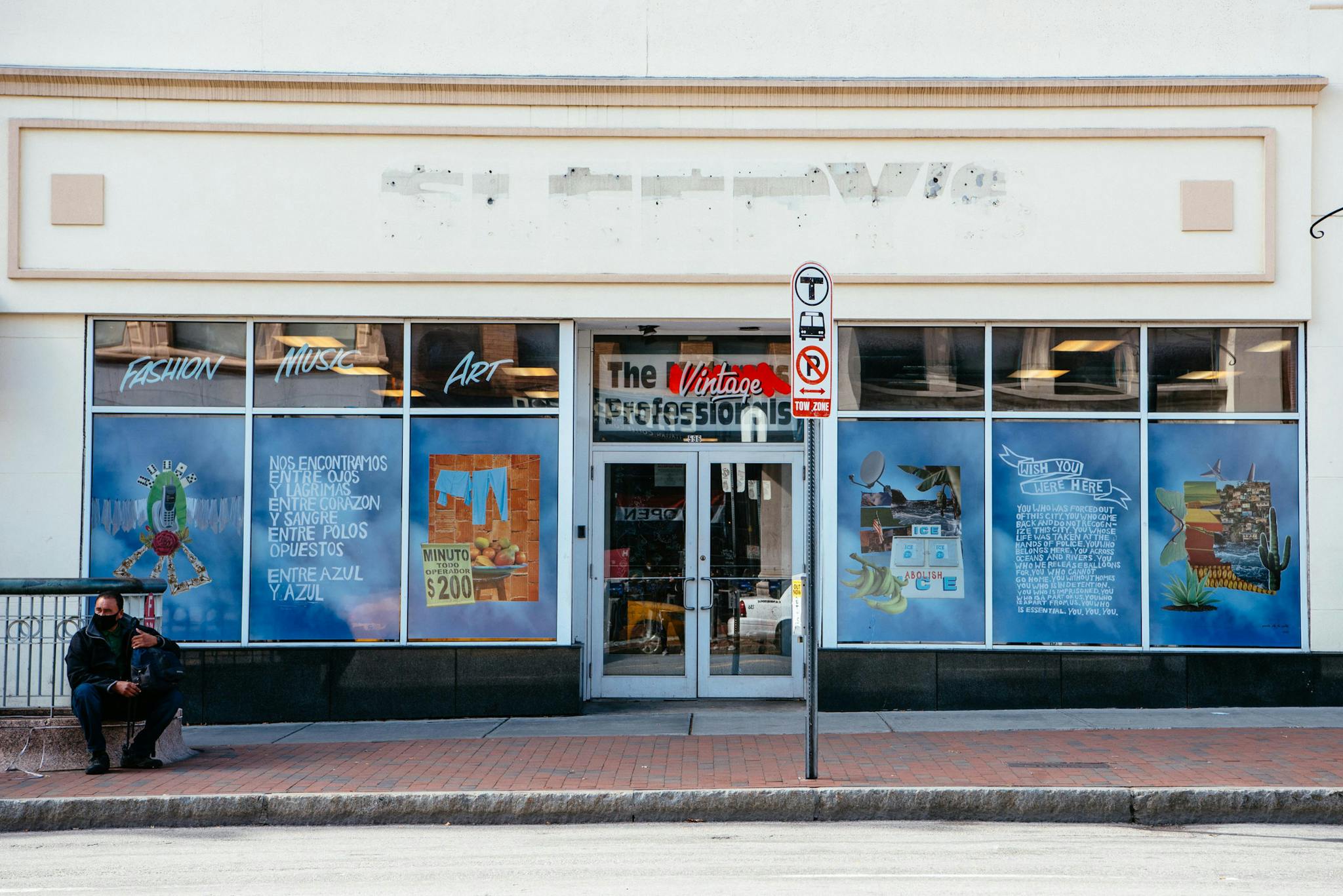Doorknocker hoops, mangoes, prickly cacti, a line of clothes hanging out to dry: Paola de la Calle’s work Entre Azúl y Azúl (Between Blues) incorporates images representing the Caribbean, Latin American, and African immigrants that filled Central Square’s streets. Created for and displayed in windows at 596 Mass Ave in Cambridge, de la Calle’s artwork tackles the issues of displacement and the rising financial barriers of access for the communities that call—or once called—the neighborhood home.
As an artist, de la Calle often reaches back to the past, something that is reflected not only in her themes of nostalgia and memory, but also in the mediums she utilizes. Her use of printmaking nods to the role of the printing press, which allowed for the mass production and distribution of knowledge that facilitated political movements and revolutions as early as the 1500s up through the Civil Rights Movement of the 1960s. She incorporates traditional crafts honed by generations of women—like sewing and quiltmaking—into her fine art works. And even her collage imagery recalls the damaging effects of colonialism. She often relies on National Geographic as a source for her image samples, and like the magazine—which has historically gone into communities, photographed what it needed, and left—de la Calle retaliates with a similar extractive approach, cutting out stacks of pictures that she reworks to tell her own stories.
With Entre Azúl y Azúl (Between Blues), de la Calle brings the past into the present. “I think as a local artist it’s important for me to remind people (who are not from the area) of the space that they are taking up—and who used to be there and who used to live in the homes that are now remodeled and unaffordable,” she explains. “Over time, a lot of the people who made Cambridge a really special place got kicked out; they couldn’t afford to live there anymore—my family being one of them. A lot of that had to do with policies around rent control.”
The series of collages utilize images of goods that someone might have found in the homes and local corner stores in the community, like bunches of bright green plátanos or the phone and calling cards that folks used to contact family overseas. “It was important for me to include images that were directly tied to Cambridge, things that you could identify if you were someone who was from there,” de la Calle says.
Thanks to the Central Square Business Improvement District’s Speak Your Piece campaign curated by artist Rixy Fernandez, the art was displayed in her old neighborhood. “What was most beautiful, or liberating, about this project was that I was finally able to take up space in this city that in many ways said, ‘You gotta get out,’” she explains.
It was a chance to reclaim that space, create room for dialogue, and a prompt for people to interrogate the spaces they were investing in and living in. “My hope is that it continues a conversation or, if that conversation wasn’t being had, that it creates space for a conversation—that then, in those spaces, those seeds are planted and they take root and they keep going,” de la Calle says.
While the visuals themselves play a key role in planting those seeds, the text and poetry she includes help to guide viewers into understanding the meaning behind the work. The “Wish You Were Here” panel captures the strong emotions that drove the piece. “All of the text there is hand-carved on linoleum and then printed on paper and then photographed and digitally altered to fit into those dimensions,” explains de la Calle. “The long process of carving ‘You who was forced out of this city’ and naming who isn’t here that I wish was… I think that was a really good release of what I was holding in and feeling really angry about for a really long time,” she says. “And not that it doesn’t still make me angry, but I like that it’s still there; people not from Cambridge stop and read it and people that are from here and can relate to missing folks who fit in that little tiny poem are reading it too.”
For de la Calle, who comes from a writing background, incorporating text is also a way of processing. “Text sometimes says what the images can’t,” she says. “When you’re using text and image side by side, they’re kind of having a conversation together and telling a story together.” Reducing the chance of misinterpretation is important, given that her works focus on topics like food justice, immigration, and inequity.
Her exploration of the effects of uprooting people, and the displacement that results from government policies, goes beyond the borders of Cambridge. In may of 2021, her quilts were carried during the Caravan for the Children, a campaign demanding the release, reunification, and healing of migrant children still being held in ICE custody. Her art was able to help draw attention to the issue and complement the movement but, as de la Calle notes, art is rarely the solution itself. “Sometimes art creates a narrative around possibility, or it creates a narrative where folks can feel represented. But representation isn’t enough, and awareness isn’t enough.”



